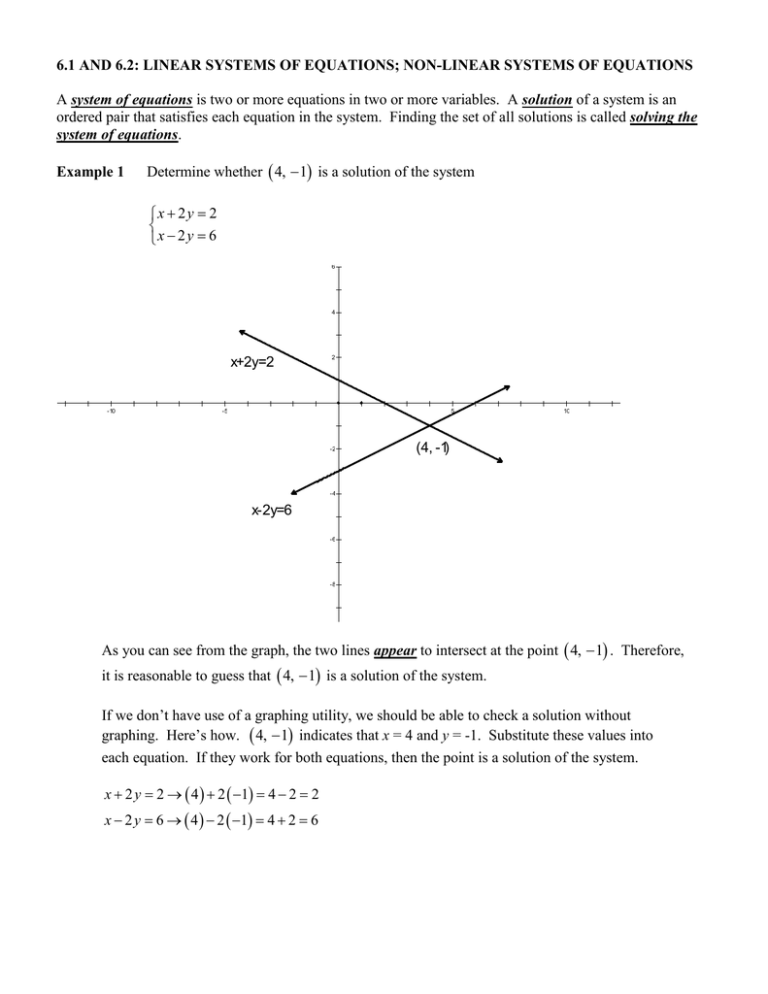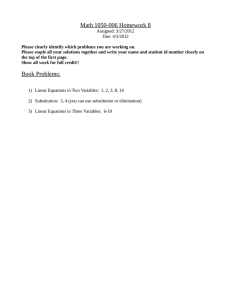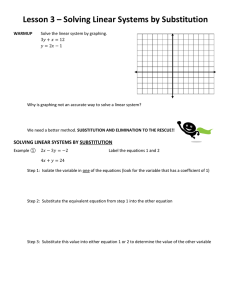MATH 1314 SPRING 2015 6.1 6.2 systems.doc
advertisement

6.1 AND 6.2: LINEAR SYSTEMS OF EQUATIONS; NON-LINEAR SYSTEMS OF EQUATIONS A system of equations is two or more equations in two or more variables. A solution of a system is an ordered pair that satisfies each equation in the system. Finding the set of all solutions is called solving the system of equations. Example 1 Determine whether 4, 1 is a solution of the system x 2 y 2 x 2 y 6 6 4 x+2y=2 -10 2 -5 5 -2 10 (4, -1) -4 x-2y=6 -6 -8 As you can see from the graph, the two lines appear to intersect at the point 4, 1 . Therefore, it is reasonable to guess that 4, 1 is a solution of the system. If we don’t have use of a graphing utility, we should be able to check a solution without graphing. Here’s how. 4, 1 indicates that x = 4 and y = -1. Substitute these values into each equation. If they work for both equations, then the point is a solution of the system. x 2 y 2 4 2 1 4 2 2 x 2 y 6 4 2 1 4 2 6 Using the Substitution Method 1. Solve one of the equations for one variable in terms of the other. 2. Substitute the expression found in Step 1 into the other equation to obtain an equation in one variable. 3. Solve the equation obtained in Step 2. 4. Back-substitute the variable obtained in Step 3 into the expression obtained in Step 1 to find the value of the other variable. 5. Check that the solution satisfies each of the original equations. Example 2 3, 1 Solve the system: x y 4 x y 2 Example 3 3, 4 Solve the system: x y 1 4 x 3 y 24 Linear Systems Having No Solutions or Infinitely Many Solutions The following three possibilities exist when graphing two lines: -10 6 6 6 4 4 4 2 2 2 -5 5 10 -10 -5 5 10 -10 -5 5 -2 -2 -2 -4 -4 -4 -6 -6 -6 -8 -8 -8 10 The two lines intersect at exactly one point. The two lines are parallel. The two lines are identical. One solution System is CONSISTENT No Solution System is INCONSISTENT Equations are INDEPENDENT Infinitely Many Solutions Equations are DEPENDENT Example 4 Solve the system: 6 2x y 3 6 x 9 y 12 Example 5 Solve the system: y 3 2x 2 x y 3 Solving a nonlinear system by the substitution method Example 6 Solve by substitution: x 2 2 y 10 . 3x y 9 Graphically, here is the picture of what’s happening: 8 6 4 x2=2y+10 (4, 3) 2 -4 -2 2 4 6 8 10 -2 -4 -6 (2, -3) 3x-y=9 -8 -10 -12 From the graph, you can see that the parabola and the line intersect in two points: (2, -3) and (4, 3). Therefore, it would seem that there are two solutions to this system. Let’s see how to do this algebraically. Example 7 Solve by the substitution method: x2 y 1 4 x y 1 Here’s the graph: 35 30 25 4x-y=-1 x2=y-1 20 15 10 5 -10 -5 5 10 Example 8 Solve by the substitution method: y x 2 14 x 49 x y 13 Here’s the graph: 18 16 14 12 10 8 6 4 2 -10 -5 5 -2 -4 10 15 20


